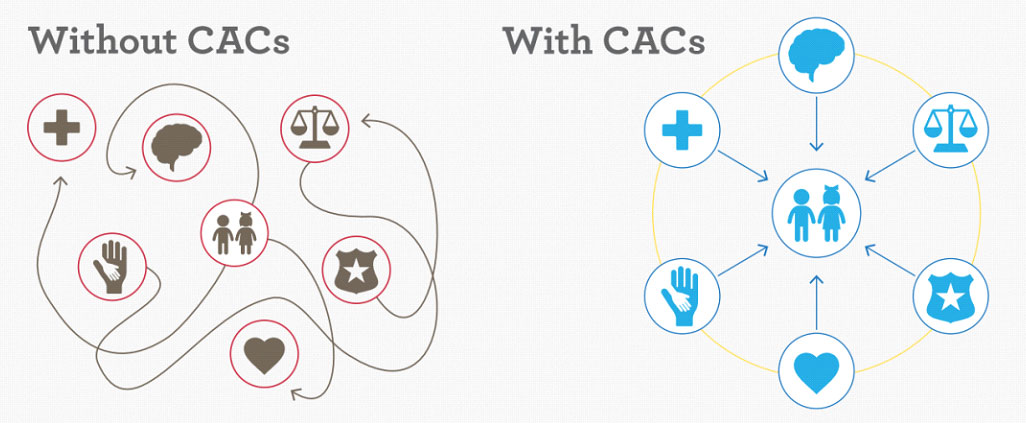CAC
Model
WHAT IS A CAC?
Children’s Advocacy Centers are child focused, facility-based programs in which representatives from many disciplines work together to conduct interviews and make team decisions on cases of child abuse. CAC models for child abuse intervention are proven and effective, bringing together trained professions to investigate and provide medical and mental healthcare as well as support child victims of abuse, while holding offenders accountable through the court system. CAC locations are child focused and designed to a sense of safety and security for child victims.

WHAT IS AN MDT?

Members of the Multidisciplinary Teams work together to reduce the secondary trauma young victims may experience from navigating a confusing system, while enhancing the system’s ability to respond to child maltreatment. Each Multidisciplinary Team is comprised of child protective services, law enforcement, prosecution, medical and mental health providers, forensic interviewers, victim advocates, and others who work together to coordinate the investigation of allegations of child abuse and provide the child victim and family with support services.
Why Is The CAC Model Important?
To understand what a Children’s Advocacy Center (CAC) is, you must understand what children face without one. Without a CAC, the child may end up having to tell the worst story of his or her life repeatedly, to doctors, cops, lawyers, therapists, investigators, judges, and others. They may have to talk about that traumatic experience in a police station where they think they might be in trouble or may be asked the wrong questions by a well-meaning teacher or other adult that could hurt the case against the abuser.

When police or child protective services believe a child is being abused, the child is brought to the CAC—a safe, child-focused environment—by a caregiver or other “safe” adult. At the CAC, the child tells their story once to a trained interviewer who knows the right questions to ask in a way that does not retraumatize the child. Then, a team that includes medical professionals, law enforcement, mental health, prosecution, DCF, victim advocacy, and other professionals make decisions together about how to help the child. Therapy and medical exams, victim advocacy, case management, and other services are offered either at the CAC or through linkage agreements. This is called the multidisciplinary team (MDT) response and is a core part of the work of CACs.
CAC/MDT Services
Through the CAC, children and families are linked to medical, mental health, victim advocacy and other services as determined on a case-by-case basis. These services may be offered directly at the CAC or through a linkage agreement with another MDT partner. The CAC model ensures that the CAC staff and MDT partners take on the responsibility of finding and providing the best combination of services and resources for each individual child and family. These services may include the following:
Forensic Interviews
Forensic interviews are neutral, non-biased and aimed at eliciting facts from children in a developmentally appropriate manner.
Forensic Medical Exams
Coordinate medical exams. When necessary, child advocacy centers will ensure that children receive appropriate medical attention.
Multidisciplinary Team
Case Reviews
Coordinate a multidisciplinary team for response to child abuse allegations.
Mental Health Support
Offer mental health services for victims and their families.
Court Preparation
Offer victim support and advocacy to clients throughout the investigation and legal proceedings. Conduct case tracking to monitor case progress.
Community Education & Prevention
Train adults on how to better protect children from child secual abuse.

